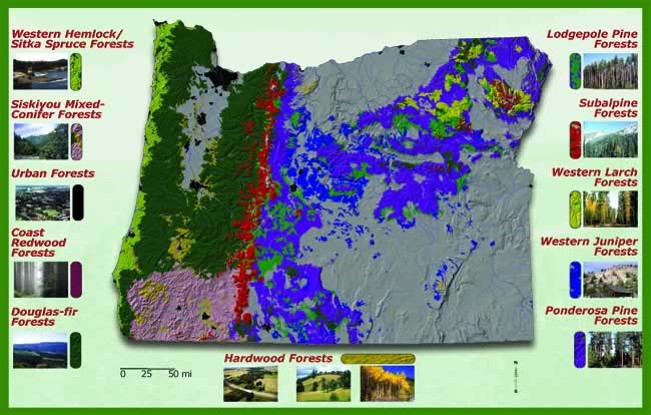By Norma Kline, Oregon State University Extension Forester for Coos and Curry Counties
Have you encountered the various terms used to characterize the vegetation on your woodland? You might have read about ecoregions, forest types or stand types and wondered how they relate to your ownership. Or perhaps these terms seem confusing because your property is classified within the Douglas-fir forest type but your trees consist of bigleaf maple and western redcedar. Foresters, ecologists and land managers group vegetation into units so they can describe and understand how forests develop and grow in a given area. One of the broadest classification approaches is the ecoregion which is used to describe portions of the state with similar climate and vegetation. Oregon only has eight terrestrial ecoregions, so these are pretty broad and expansive ways to describe vegetation areas. For the most part, our coastal counties fall entirely within the Coast Range ecoregion, an important exception is Curry County, which also includes the Klamath Mountains ecoregion. If you live in Curry County I bet you already know that your forests are pretty unique! The other nearby ecoregions are the Willamette Valley and West Cascades. Figure 1 shows the eight terrestrial ecoregions in Oregon. There is also a ninth ecoregion, the nearshore marine area.

BM = Blue Mountains
CP = Columbia Plateau
CR = Coast Range
EC = East Cascades
KM = Klamath Mountains
NBR = Northern Basin
and Range
WC = West Cascades
WV = Willamette Valley
The Coast Range ecoregion is characterized by steep mountains and narrow ridges dissected by numerous streams and rivers. The marine influence gives this area the distinction of having the wettest and mildest weather in the state; providing perfect conditions for growing productive forests! The Klamath Mountains ecoregion is comprised of mountain peaks that reach over 7,000 feet in elevation as well as broad flat valleys. The underlying geology in this region is truly unique, consisting of serpentine mineral bedrock which in turn influences the types of species growing here. The high species diversity of the Klamath Mountains include some species that are only found in this region.
If you live on the coast you may have heard of another area described as the coastal fog belt. This strip of land is cool and moist for much of the year due to the coastal fog influence. In coastal valleys and lowlands, the fog belt may extend 15 to 20 miles inland. In other areas, it may only be a few miles wide. The coastal fog belt is characterized by spruce and hemlock forests that thrive in this cool and moist climate. Climate, elevation, wind and rainfall, temperature and soil influence the type of forests that dominates an area. These forest types are another way to characterize the landscape. The Spruce Hemlock forest type overlaps with the coastal fog belt. The remainder of the Coast Range ecoregion is classified as Douglas-fir and Hardwood forest types and the Klamath Mountains ecoregion is classified primarily as the Mixed Conifer Forest type. The dominant forest types in Oregon are represented in Figure 2.

How does the property described earlier, consisting mostly of western redcedar and bigleaf maple fit into the forest type classification? The property falls within the Douglas-fir forest type which covers an expansive geographic area characterized by its most dominant tree type, Douglas-fir. But there are also many other species present within the Douglas-fir forest type and in some areas, depending on past management or unique site characteristics, there might not be any Douglas-fir at all! This is why many woodland owners describe their property in terms of groups or trees or “stands” that are currently present. How a woodland owner describes these stands of trees on their property is up to them. For example, one woodland owner might describe a five acre patch of red alder as a “red alder” stand while her neighbor might lump an entire slope together and describe it as a “Douglas-fir/red alder” stand. Stand types are a way to describe an area that fits the management goals of the landowner. If you are interested in developing a management plan for your property, one of the first steps is to consider your goals and objectives and delineate stand types. A great resource to help with management planning and deciding how to characterize stands on your property is the Oregon Forest Management Planning website: http://blogs.oregonstate.edu/forestplanning/
What kind of forest do you live in? You might live in the Coast Range ecoregion in the narrow fog belt within the Spruce Hemlock Forest type. But when you start getting to know your property and mapping out individual stand types you might describe your property as having red-alder stands, mixed Port-Orford-cedar/spruce/hemlock stands and maybe even a shore pine stand. Or you might live in the Klamath Mountains ecoregion and have very diverse mixed conifer stands. However you choose to label your woodland I bet you are passionate about taking care of it. Check out the Know Your Forest website https://knowyourforest.org/ and the Oregon State Extensions catalog https://catalog.extension.oregonstate.edu/ for more resources to help you understand and manage your small woodland.

